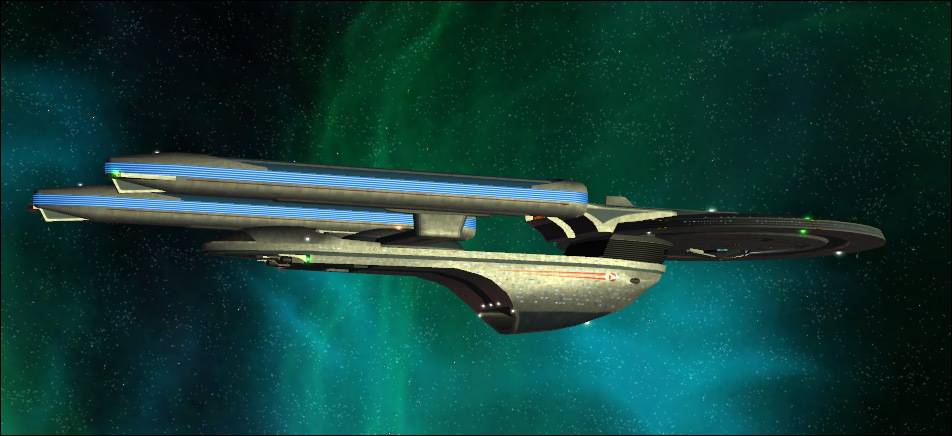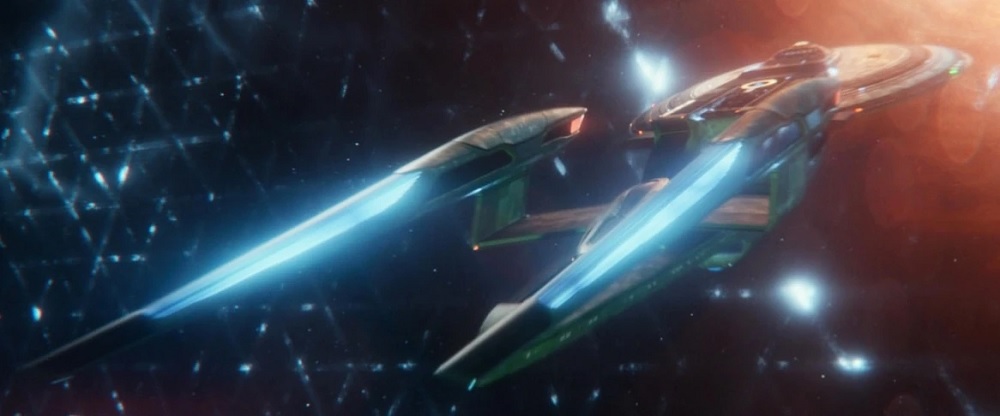Excelsior Class
Created by Fleet Admiral Luzol Targaryen on Sun Aug 13th, 2023 @ 3:21am
Excelsior Class
 | |
| Affiliation: | Federation Starfleet |
| Service Period: | 23rd - 25th Centuries |
| Length: | 467 meters |
| Width: | 185 meters |
| Height: | 100 meters |
| Mass: | 2,150,000 metric tons |
| Decks: | 28 |
| Crew: | 700 personnel |
| Speed: | Warp 9 |
| Armament: | Phaser Banks Torpedo Launchers |
| Defenses: | Shields |
| Auxiliary craft: | Starfleet Shuttlecraft |
Overview
As the 2260s drew to a close, technological development within the United Federation of Planets exploded at a record pace and starship design would never be the same. While Starfleet had successfully implemented their new Constitution II Class starships, at the rate of technological growth impacting the Federation, Starfleet Command knew that their existing designs would not be able to keep up with the rapid proliferation of technologies. Dubbed "The Great Experiment," the new Excelsior Class would become Starfleet's answer to a changing universe.
Construction of the prototype U.S.S. Excelsior would be completed in 2285 and the vessel would be outfitted with Starfleet's new, experimental Transwarp Drive. Designed to allow almost instantaneous travel throughout the galaxy, Transwarp Drive would be an unrivaled breakthrough that would allow the Federation access to all corners of the galaxy. During testing in the Sol Sector in which the Excelsior was sent to intercept the U.S.S. Enterprise, the Transwarp Drive experienced a catastrophic failure of its engines. During analysis by the Theoretical Propulsion Group, it was determined that the Transwarp Drive was unable to maintain a stable Transwarp Field and the project was scrapped.
Undeterred, the Advanced Starship Design Bureau reviewed the Excelsior Class and returned the prototype to Spacedock and postponed further construction of Transwarp equipped hulls. Identifying that the technologies used in the Excelsior were highly advanced and, aside from the Transwarp Drive, operational, the Corps of Engineers agreed to complete construction on the remaining vessels and retrofit the existing vehicles with traditional Warp Drives. After these changes the Excelsior proved itself as an adaptable, versatile vessel through the remainder of the 23rd Century all the way through the early 25th Century.
Capabilities
Reminiscent of the Constitution Class, the Excelsior was constructed with a saucer shaped primary hull and a long engineering hull containing the ship's Warp Nacelles. Unlike the Constitution, the pylon connecting the primary and secondary hulls was expanded with additional technologies to help eliminate the weak-point that existed in the Constitution. Following the removal of the Transwarp components, the Excelsior's bridge module was replaced, Impulse Engines modified, and the engineering hull cargo bays expanded.
Originally designed to house a Transwarp Drive, the Excelsior features more fusion reactors and Warp Coils than any other contemporary design - which allowed the vessel to maintain high warp for longer periods than any of its counterparts. In many situations Excelsior Class vessels were known to risk to overload of their Warp Core or structural collapse before the failure of the nacelles themselves due to the design of their coil assembly. The enhanced energy generation of the Excelsior's power systems broke Starfleet records for sublight acceleration and allow the Excelsior to maintain shield integrity during heavy attack from opponents.
A workhorse within Starfleet for generations, Excelsior Class ships were outfitted with the latest generation of Duotronic Processors when launched. These computer systems interfaced directly with the scientific systems of the Excelsior, allowing faster analysis and processing of data provided from the Excelsior's sensors and research laboratories. Identifying the limitations of Phaser coverage on its predecessors in the Constitution Class, the Excelsior Class had additional Phaser arcs than its ancestor and additional Torpedo Launchers installed to increase the offensive capabilities of the starship. Due to all of the enhancements and power available to the Excelsior, members of the class served with distinction from the latter days of the 23rd Century until the earliest years of the 25th.
Refits and Variants
Due to the failure of Transwarp Drive testing, the default version of the Excelsior Class is by technicality a variant of the original design due to the inclusion of a traditional Warp Drive and served as the dominant design of the Excelsior Class during its entire lifetime. Following the discovery of a Klingon Bird of Prey that could fire its weapons while cloaked, Starfleet Command ordered a revised Excelsior Class that incorporated additional impulse engines, modifications to the warp nacelles, and an expansion of the engineering hull to house advanced sensor technology capable of overcoming the advantages of this new Klingon Cloaking Device. While this modified Excelsior met all design briefs issued by Starfleet, the design never saw widespread usage due to the lessening of hostilities between the Federation and Klingons.While Excelsior Class vessels underwent routine upgrades throughout their lifetime to keep apace of technological development, the Excelsior would not see a widescale upgrade until first contact between the Federation and the Dominion. At the direction of Admiral James Layton, the U.S.S. Lakota was upgraded to include advanced tactical capabilities including ablative hull armor, multiphasic shielding, latest generation phaser banks, and even Quantum Torpedoes. Due to the resources needed and the length of time required to refit even a single Excelsior Class to these specifications, Starfleet Command ordered the development of the Excelsior II and Obena Classes in place of the refit.
Mission Profiles
Explorer, Scientific and Survey Operations, Strategic and Diplomatic Operations. Excelsior Class vessels were designed to replace the Constitution Class as Starfleet's primary explorer in the late 23rd Century.
Naming Conventions
Starships of the Excelsior Class are named in honor of great achievements, exploratory concepts, and famous leaders from throughout the Federation's history.
Notable Starships
U.S.S. Excelsior, Class Prototype U.S.S. Enterprise-B U.S.S. Hood U.S.S. Lakota U.S.S. Repulse U.S.S. Roosevelt U.S.S. Sarek U.S.S. Stardancer U.S.S. Valley Forge
Excelsior II Class
 | |
| Affiliation: | Federation Starfleet |
| Service Period: | 24th - 25th Centuries |
| Length: | 588 meters |
| Width: | 233 meters |
| Height: | 126 meters |
| Mass: | 2,709,000 metric tons |
| Decks: | 35 |
| Crew: | 800 personnel |
| Speed: | Warp 9.9 |
| Armament: | Phaser Arrays Torpedo Launchers |
| Defenses: | Covariant Shields |
| Auxiliary craft: | Starfleet Runabouts Starfleet Shuttlecraft |
Overview
Following the devastating first contact between the United Federation of Planets and the Dominion, Starfleet Command ordered an immediate review of all current Starfleet vessels to assure that they were capable of withstanding onslaught from the forces of the Dominion. The workhorse of the fleet, the Excelsior Class was one of the first vessels reviewed and several critical deficiencies were discovered that called into question the design's ability to survive. Starfleet Command ordered a refit to enhance the Excelsior, but Admiral James Layton took it a step further and ordered an expanded upgrade to the U.S.S. Lakota to support tactical capabilities mimicking the Galaxy Class. During a live fire confrontation with the U.S.S. Defiant, the Lakota was overwhelmed by the smaller Defiant Class starship albeit barely. While the Lakota Refit was deemed a success, Starfleet Command opted to cancel further production of the Lakota variant in favor of a new Excelsior II Class.
Designed in parallel to the Obena Class, the Excelsior II was designed to fulfill a more tactically oriented disposition than her Excelsior Class ancestors. Designed to be both formidable and maneuverable, the Excelsior II employs many technologies typically utilized by Starfleet Intelligence and Starfleet Tactical. While not an intelligence vessel herself, the Excelsior II features many advanced systems that allow her to serve close to hostile territory, able to respond to crisis situations without fear and uphold the ideals of the Federation.
Capabilities
The Excelsior II Class supports the same primary hull and engineering hull layout as the earlier Excelsior Class. The oval shaped primary hull maintains the vessel's Bridge and crew support areas while the secondary hull has the vessel's engines and support systems. The Excelsior II featured angular nacelle pylons supporting its Warp Nacelles, enhancing the design's Warp Field by 18%. Due to the presence of additional fusion reactors, the Excelsior II has a faster acceleration rate than its contemporaries, and the design itself does not have the typical assortment of research facilities and laboratories available for a ship its size.
One of the most unique defensive attributes of the Excelsior II is the inclusion of a Covariant Shield Grid in its construction. Utilizing tetryon-based technology, Covariant Shields are similar to a standard deflector except they interfere with the ability of an opponent to lock on to the Excelsior II when active. Combatants with enhanced sensors can sometimes establish a lock onto the Excelsior II, but they are usually unable to scan the internal hull of the Excelsior, regardless of their proximity.
Equipped with both Phasers and Torpedo Launchers, the Excelsior II is well armed for a vessel its size. The Excelsior II is able to redirect power in emergencies to better support its tactical profile, increasing the rate of fire for both its Phasers and Torpedoes. While the power drain is immense, the tremendous power directed through the vessel's weapons creates a devastating assault upon an enemy. While auxiliary couplings channel excess power to avoid overheating issues, but the possibility of overload is a real threat to the Excelsior II when employing this maneuver. In their default configuration the Phasers of the Excelsior II can deliver a traceable payload which will allow the ship to track an enemy at great distance.
Refits and Variants
While the Excelsior II is effective at long-range cartography missions, intelligence gathering, and scouting assignments, the Excelsior II is not well suited for standard scientific and survey missions. Identifying this deficit, Starfleet Command ordered a refit to the Excelsior II to expand its research capabilities by installing new modular laboratories at the expense of some of the vessel's storage bays, impacting the Excelsior II's ability to respond to crisis situations.
Mission Profiles
Crisis and Emergency Response, Pathfinder and Reconnaissance Operations, Strategic and Diplomatic Operations. While closely resembling their predecessor, Excelsior II Class vessels were designed to handle emergency and strategic assignments over the purely exploratory mission profiles.
Naming Conventions
Starships of the Excelsior II Class share the naming protocols of the Excelsior Class and honor great achievements, exploratory concepts, and famous leaders from Federation history.
Notable Starships
U.S.S. Excelsior, Class Prototype U.S.S. Eureka U.S.S. MestralCategories: No categories found